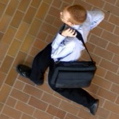Sunday, December 28, 2003
Ah, Byzantium!
I'm currently reading William R. Hutchison's extremely rewarding new book, Religious pluralism in America: The contentious history of a founding ideal. (Hutchison was one of my professors at Harvard Divinity School.) I'll have a lot to say about the book over the next few weeks, but today Mrs Philocrites and I experienced a bit of American religious pluralism by attending her grandmother's Byzantine-rite Ukrainian Catholic church in New Jersey. Wow.
Post-Mormon liberal Protestant that I am — another topic we can come back to sometime — I've had very little exposure to the Roman Catholic mass (only twice, actually), but I have attended a lot of Episcopal church services ("high" and "low") and two Greek Orthodox services. Byzantine-rite Catholicism certainly reminded me of the Orthodox liturgy and hardly resembled the masses I've attended at all. Mrs Philocrites' grandmother grew up in this congregation of Ukrainian immigrants, and raised her children there (although all five have since gravitated to Methodism, Quakerism, Roman Catholicism, or what we might call Lord-of-the-Ringsism). Her grandfather helped make the original church's onion dome; the congregation now occupies a spectacular modern church decorated by the most amazing icons and a gilded chancel screen ("iconostasis") of wheat and grape motifs. The icons in the sanctuary were surely the most beautiful I've ever seen, and I couldn't help but think how odd it is to encounter art like this in a museum rather than in a worship service — the experience is so different. (We went to the Met yesterday to see the El Greco exhibit; how utterly amazing that art would be if it could somehow be transported into a church!)
The service was conducted primarily in Church Slavonic, and everything is chanted by the priest, the cantor and choir, and congregation. (This high degree of congregational participation was especially interesting to me, since that was one of the goals of Luther and Calvin and the other Protestant reformers.) Although verses of "Silent Night" and "Joy to the World" were interspersed with the chants that opened the service and sung — in Church Slavonic — as a kind of recessional hymn, there were no "hymns" as Protestants would think of them. There were also no instruments.
The bread is placed in the communion wine, and then taken from the chalice and placed in the communicants' mouths with a spoon. (There's a helpful description of the rite at the Catholic Information Network site.) Unconsecrated bread is kept near the door for everyone to take as they leave; it was quite yummy.
Mrs Philocrites was amused by how clearly I stood out, with my English-Swedish face and bright red hair. We were both delighted by the name for the parish's new youth group: ByzanTeens.
Copyright © 2003 by Philocrites | Posted 28 December 2003 at 5:49 PM
Previous: Divide and conquer.
Next: The church of Utne readers.


4 comments:
Melanie:
December 29, 2003 07:33 AM | Permalink for this comment
I don't know what kind of liturgical theology they taught you at Harvard, but the Eastern Rite Catholic Churches' liturgies don't look much like the Roman Rite Mass because they are Eastern Rite: they are Orthodox Rite churches in communion with Rome.
boy in the bands:
December 29, 2003 10:22 AM | Permalink for this comment
The TA for my first religion class in college was a member of the local UU fellowship and held minor orders (subdeacon) in the Carpatho-Russyn Orthodox Church. (Who says you can't have it both ways?)
But taking the antidoron (lit. "not the gift") are we, Philo? The reception of the blessed but unconsecrated bread by the non-Orthodox is a matter of grave controversy, but presumably a controversy the Byzantine rite has avoided or buried. It should be noted that the antidoron was a part of worship in Western Europe until the (I think) 10th century.
My one regret from my 1998 trip to Jerusalem was not taking the antidoron offered me at the Syriac church of St. Mark (over the traditional site of The Upper Room) -- I didn't know what it was then, and didn't want to falsely present myself as being in communion with that church. The priest was kinder than my misgivings allowed . . . .
Philocrites:
December 29, 2003 11:09 AM | Permalink for this comment
Perhaps I committed a faux pas. I did not take communion, but when Mrs Philocrites' grandmother told us to take some of the "antidoron" (thanks for telling me its name!), I did what I was told. I'll let the good Lord sort it out.
the boy, again:
December 29, 2003 05:15 PM | Permalink for this comment
Fear not about doing the right thing. A certain Coptic rite church that meets in a certain Universalist church I know has been known to (but no longer does) leave out biscuit-sized hunks of antidoron, which has gone for the corporal (if not spiritual) benefit of vermin.
I figure if it is good enough for a rat, it is good enough for you or me. (But don't tread on that glue trap.)
Comments for this entry are currently closed.